First Congregation Sons of Israel
161 Cordova St, St. Augustine, FL 32084
April 7, 2022
The First Congregation Sons of Israel was chartered with the State of Florida in 1908. The first group of families came from Eastern Europe and Russia. Before the synagogue was built, services were held in members' houses. The first service held in the synagogue was on March 30, 1924, thanks to Rabbi Jacob Tarlinksy and his wife, Dora. In 1958, the colorful stained glass windows were installed by the Tarlinksy family, and in 2013, they underwent a restoration. In 2018, the sanctuary was reopened after Hurricane Mathew destroyed the synagogue.
https://www.firstcongregationsonsofisrael.com/
The stunning stained glass windows in the synagogue have a remarkable story behind them. In the 1950s, three women in the congregation managed to salvage a set of stained glass windows from Ahawas Achim in Atlanta, Georga. Ahawas Achim was a synagogue that was torn down to make room for Interstate 75. Over time the stained glass needed to be refurbished due to damage, and miraculously, the original stencils were found. Ken Hardeman (the great-grandson of the man who helped create the stained glass) was the one to start and complete the restoration project leaving it to look flawless to this day. Now the exterior is covered by tempered glass to protect them from damage.
Pictured here is an alter called a "bihma," and this is where the Torah is read from during a service.
Image in Conversation 1
The Eldridge Street Synagogue, found in Manhattan's
Chinatown, is the first synagogue in America that was "purpose-built"
by immigrants from Eastern Europe. It was built in 1887 when there was a
spike in immigration to the United States. It became more than just a
place of worship to these immigrants; it became a home. Unfortunately,
around 1924, there was a decline due to the Immigrant Quota Law. This law
limited the number of immigrants allowed to enter the U.S. After this law
was passed, the community started to thin out, leading to the steady decline of
the Jewish population in the Lower East Side. Eventually, in the 1940s,
the congregation relocated to the lower level chapel and shut down the massive
area above them. This led to the building slowly deteriorating.
Fortunately, in 1986, the hidden sanctuary was rediscovered, and the community
began to restore it. After the restoration was complete, it was redacted
as the Museum at Eldridge Street.
The reason that this synagogue stuck out to me
was because of the stained glass. The museum commissioned artist Kiki
Smith and architect Deborah Gans to create a stained glass window that symbolized
"the continuing life" in the building. This is similar to how
the stained glass in the First Congregation Sons of Israel Synagogue brought
color and life into the building.
Image in Conversation 2
Another synagogue that the First Congregation Sons of
Israel reminded me of was Kahal Kadosh Beth Elohim. This house of worship was built in 1840 in
Charleston, South Carolina. It is one of the oldest Jewish congregations
in the United States and is the second oldest that is still in use. It
was founded by immigrants that were escaping the Inquisition; many arrived in
the 17th century. Jews were accepted into Charleston because of the
colonial charter prepared by John Locke. This allowed Jews to worship and
live freely. This synagogue is still thriving to this day, and they
claim that they are more than a house of worship; they are a "vibrant,
caring congregational family."
ENG 202 Passage
While we were in the synagogue, I could not help but think of community and motivation. Religions bring people together and give them hope when life gets complicated. I am connecting this back to Parable of the Sower, page 220 because there is a panel where Lauren talks about how even after she lost everything, she still had her beliefs. She says, "When my father... disappeared... when most of my community and the rest of my family were wiped out... Earthseed kept me going". This quote explains how her religion motivated her to continue trying to survive, and even though her situation is extreme, it still aligns with the idea that many people going through hardships, whether minor or not, turn to religion for motivation and support.
Creative Component










No comments:
Post a Comment